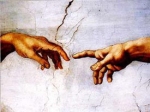Verse: Lev 16:3-4 But in this way Aaron shall come into the Holy Place: ....He shall put on the holy linen
coat and shall have the linen undergarment on his body, and he shall tie the linen sash around his waist,
and wear the linen turban; these are the holy garments. ESV
There were three types priestly robes used during the Tabernacle and Temple worship service in the old
covenant.
1. Priest Robe. – White linen, four layers, used on all days by the priests during their hours of
service.
2. Golden Garments - worn only by the high priest, eight layers, including the breastplate with
twelve gem stones representing the twelve tribes of Israel, skillfully woven tunic with blue,
red and gold threads with a bottom fringe of bells and pomegranates, white turban with a
golden miter. This was worn on all days except on Yom Kippur, the Day of Atonement.
Exodus 28:4
3. White Garments – worn by the high priest only on Yom Kippur (the Day of Atonement), four
layers, all white, made from finely twined linen. (Leviticus 16:4). He wore two tunics, one in
the morning and one in the evening. When he concluded the service for that day, he took
off the white linen and never wore them again, they were only worn once. (Leviticus 16:23)
Types, shadows and the substance.
We are told in the New Testament Scriptures that both the days (feasts, Sabbaths, New Moons, etc.)
and the priesthood along with their service are “a copy and shadow of heavenly things”. Also:
Hebrews 8:5
when Moses was about to erect the tent, he was instructed by God, saying, "See that you make
everything according to the pattern that was shown you on the mountain." ESV
So the value for us today is to look into the details that were inspired by YHWH himself through Moses
to help us define and understand “substance” which is Christ.
Read: Colossians 2:16-23 and Hebrews 8.
The types and shadows are not to be discarded because they are incomplete. Rather they need to be
explored and deciphered like clues to the great mystery which is Christ.
I find it significant that the conclusion of our life in the kingdom of heaven does not begin and end with
salvation. Today we are positioned in time where the Passover of Jesus Christ our Lord has been
accomplished in history. Through His once and for all atonement, every offense before the Holy Father,
Papa Abba YHWH, has been removed. There is now a door open that cannot be shut that leads us into
covenant relationship, partnership, and shalom with the Ancient of Days. We did not earn this, but we
must exercise our choice to receive it. Jesus clearly told us that He was the Door (John 10:7-9).
After we enter into this new life, (a covenant is more than a contract, it is an exchange of persons – we
give our lives to God, and He gives His life to us, this is living in the Spirit - see Luke 9:24) we are given
the indwelling Spirit of God to teach us, comfort us, empower us, convict us of where we miss the mark,
and teach us the truth. We do not know and we cannot know how to actually live in the YHWH’s
kingdom until we actually get there. Sin and separation does not instruct us in His ways. The very Spirit
of God does that. This truth is represented through the appointed time of Pentecost (Shavuot) (See Acts
2) which occurs exactly 50 days after Passover.
The Day of Atonement has not seen a historic fulfillment as have Passover and Pentecost. So why does
this event of Atonement show up AFTER the Passover event?
If Jesus atoned for our sin at Passover, what need is there of another atonement event?
The clues to the answer lie with the garments worn by the high priest and some of the unique sacrifices
that were done only on the Day of Atonement.
Every day of the year the high priest represented Israel as a nation before YHWH. He carried the twelve
precious stones on his chest, close to his heart that represented the twelve tribes of Israel. He also bore
twelve stones on his shoulders, six on each shoulder showing that he bore weight of their lives on his
shoulders at all times. The alternating bells and pomegranates on the fringe of his robe caused a muted
ringing with each step he took. The bells depict gifts of the Spirit given by YHWH, the pomegranates
depict the fruit of the Spirit. The gifts without the fruit give a clanging sound, gifts with fruit are pleasant
and soothing--the result of the sweetness of a godly culture and way of life. There are many more
symbols and details in the golden garments of the high priest but my main point is that he represented
the people before God.
On the Day of Atonement, the high priest represented our Great High Priest, Jesus Christ (Hebrews 4:14-
16). He wears only simple pure white linen, and He only wears it one time. The garments are always
fresh, pure and new. On that day we witness a picture of the Great High Priest presenting his blood (life
– the life is in the blood) before the very throne of heaven as represented by the Ark of the Covenant in
the Holy of Holies. It is significant that the high priest did these things only once a year. There is only one
atonement for all, it was fulfilled by one Man, one time and it was complete.
Jesus never failed. The Father accepted and the atonement was given to all.
There is a tale that the high priest would have a rope tied around his ankle because the “holiness” of the
Day of Atonement was so severe that if he failed in any detail of the service, the Lord would kill him
instantly and the atonement for Israel would fail for that year. The other priests could then pull out his
dead body for disposal. This is wrong on several counts.
First, the high priest was not even wearing the bells and pomegranates; he was wearing the white robes.
The priest never failed because Jesus never failed. The reason for all the exclusive requirements of Yom
Kippur emphasize that the work of redemption rest completely upon the grace and the desire of God
(Ephesians 2:8). During the times of Jesus ministry on earth, the high priesthood was corrupted. The
high priest was no longer appointed through the line of Aaron and his sons, but it was a corrupted
political appointment made through the Jewish leaders and the Roman government. Still, the picture of
YHWH’s atonement never failed. God is faithful to His pictures even when corruption attempts to
distort His true image.
Ephesians 2:4-11
But God, being rich in mercy, because of the great love with which he loved us, 5 even when we
were dead in our trespasses, made us alive together with Christ— by grace you have been
saved— 6 and raised us up with him and seated us with him in the heavenly places in Christ
Jesus, 7 so that in the coming ages he might show the immeasurable riches of his grace in
kindness toward us in Christ Jesus. 8 For by grace you have been saved through faith. And this is
not your own doing; it is the gift of God, 9 not a result of works, so that no one may boast. 10
For we are his workmanship, created in Christ Jesus for good works, which God prepared
beforehand, that we should walk in them. ESV
When we look at Yom Kippur, let us see the view from heaven on the event of Passover. Our sins are
removed, and we are in right standing with the Father. This is His work and His desire, but we must see
and accept His work and His work alone. Yom Kippur emphasizes that we do nothing, we are strictly
commanded to “deny ourselves” and then we receive the righteousness of God through Jesus Christ.
The is our greatest pleasure that never fails--Yom Kippur, the Day of our Atonement.





Terms & Conditions
Subscribe
Report
My comments